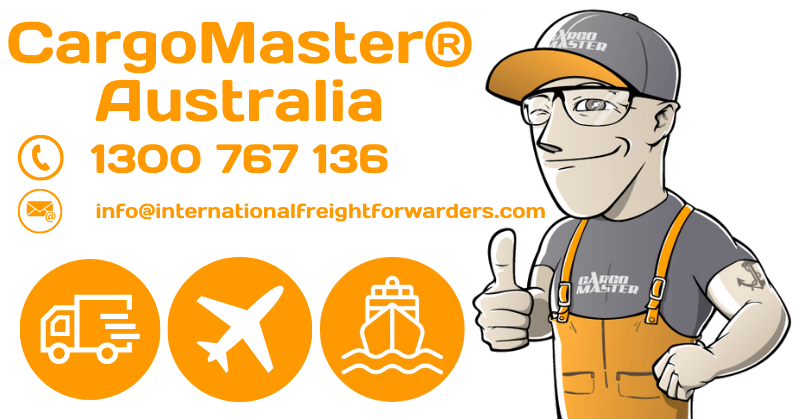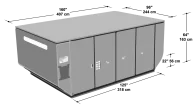Tasmania International Freight Forwarders
 When it comes to international and domestic freight forwarding in Tasmania, CargoMaster is the trusted choice for businesses and individuals alike. With years of proven experience, our team provides tailored logistics solutions that simplify the process of moving goods to and from the island state. Whether you’re shipping personal effects, commercial cargo, or industrial equipment, we deliver dependable transport options at competitive rates.
When it comes to international and domestic freight forwarding in Tasmania, CargoMaster is the trusted choice for businesses and individuals alike. With years of proven experience, our team provides tailored logistics solutions that simplify the process of moving goods to and from the island state. Whether you’re shipping personal effects, commercial cargo, or industrial equipment, we deliver dependable transport options at competitive rates.
Tasmania’s unique position as an island means efficient freight forwarding is essential for connecting local businesses to the mainland and international markets. CargoMaster understands these challenges and offers seamless solutions designed to keep trade moving. Our services cover every aspect of the supply chain, from pick-up and packaging to customs clearance and final delivery.
We specialise in both domestic freight between Tasmania and mainland Australia, as well as international shipping to destinations around the world. With access to major ports and air freight hubs, our logistics network ensures your goods move quickly and efficiently. Whether it’s urgent deliveries or bulk cargo, we have the expertise to make it happen.
At CargoMaster, we pride ourselves on providing reliable and flexible freight solutions that suit the needs of Tasmanian businesses and residents. Our commitment to outstanding customer service and transparent pricing makes us the preferred choice for freight forwarding in Tasmania.
Sydney Melbourne Brisbane Perth Adelaide Canberra Darwin Hobart
History of Freight Forwarders
 The origins of international freight forwarding stretch back to centuries-old practices in Europe. In early times, innkeepers in London acted as the first freight forwarders, holding and transporting the possessions of guests traveling across the continent. One of the earliest official freight forwarding companies, Thomas Meadows and Company, was established in London in 1836. This firm paved the way for modern logistics practices, offering services that connected clients with carriers while ensuring safe and timely delivery. Over time, mergers and acquisitions shaped the industry, with companies like Rockwell International Freight and later Delmar International expanding global freight capabilities.
The origins of international freight forwarding stretch back to centuries-old practices in Europe. In early times, innkeepers in London acted as the first freight forwarders, holding and transporting the possessions of guests traveling across the continent. One of the earliest official freight forwarding companies, Thomas Meadows and Company, was established in London in 1836. This firm paved the way for modern logistics practices, offering services that connected clients with carriers while ensuring safe and timely delivery. Over time, mergers and acquisitions shaped the industry, with companies like Rockwell International Freight and later Delmar International expanding global freight capabilities.
Back then, freight forwarders played a crucial role in arranging transportation with multiple carriers, managing essential paperwork, and keeping customers informed about the status of their shipments. Their overseas partners ensured cargo reached its destination smoothly. The fundamentals of international freight forwarding established during this period still form the backbone of the industry today.
In the digital age, the role of freight forwarders has expanded but the principles remain the same. International Freight Forwarders in Australia, including Tasmania, oversee the transport of goods across all major modes, managing customs documentation, ensuring compliance, and coordinating with global partners. The rise of e-commerce, digital tracking, and automation has made freight forwarding even more essential, with increased demand for timely and secure deliveries.
In Tasmania, international freight forwarders operate as the bridge between shippers and carriers, ensuring that cargo moves efficiently through the state’s ports, airports, and extensive road and rail networks. This combination of historical expertise and modern technology continues to shape how goods flow into and out of Tasmania.
Air Freight
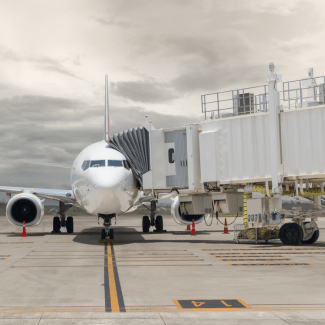 Air freight is the fastest way to transport goods in and out of Tasmania, and CargoMaster offers comprehensive air freight services that connect you to global markets. We partner with major airlines to ensure competitive pricing and reliable schedules, giving Tasmanian exporters and importers the speed they need to stay competitive.
Air freight is the fastest way to transport goods in and out of Tasmania, and CargoMaster offers comprehensive air freight services that connect you to global markets. We partner with major airlines to ensure competitive pricing and reliable schedules, giving Tasmanian exporters and importers the speed they need to stay competitive.
Air freight is ideal for urgent or time-sensitive shipments, such as machinery parts, medical supplies, high-value items, or perishable products. Our team manages everything from pick-up and documentation to customs clearance and delivery, ensuring a smooth process from start to finish. With real-time tracking available, you’ll always know where your cargo is.
For Tasmanian businesses, air freight provides a critical link to the mainland and beyond. CargoMaster offers both consolidated and direct air freight services, giving you flexibility depending on the urgency and size of your shipment. We tailor each solution to strike the right balance between speed and cost.
By choosing CargoMaster for air freight in Tasmania, you gain peace of mind knowing your goods are handled by professionals with extensive knowledge of air cargo logistics. Our team ensures your freight arrives safely, securely, and on time, no matter the destination.
Air Charter
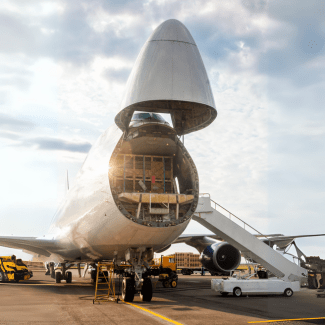 Sometimes, regular freight services aren’t enough to meet specific deadlines or transport oversized cargo. That’s where CargoMaster’s air charter solutions come in. Available across Tasmania, our charter services offer a direct, flexible, and dedicated transport option for urgent or specialised cargo needs.
Sometimes, regular freight services aren’t enough to meet specific deadlines or transport oversized cargo. That’s where CargoMaster’s air charter solutions come in. Available across Tasmania, our charter services offer a direct, flexible, and dedicated transport option for urgent or specialised cargo needs.
Air charters are particularly valuable for industries that rely on precision timing, such as mining, energy, medical, or emergency response. Whether it’s delivering vital equipment to remote locations or transporting urgent supplies, our charter services ensure your cargo arrives without delay.
With access to a range of aircraft, from small planes to heavy lift cargo jets, CargoMaster tailors charter solutions to the size and weight of your freight. This flexibility makes it possible to move everything from oversized machinery to time-critical documents with complete reliability.
Choosing an air charter in Tasmania gives you maximum control over your shipment. With end-to-end support, including permits, ground handling, and customs, CargoMaster ensures a seamless process and peace of mind for every charter flight.
Sea Freight
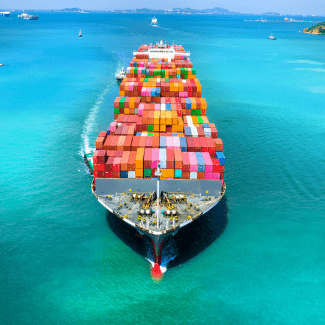 Sea freight remains one of the most reliable and cost-effective ways to move bulk cargo, and Tasmania’s ports provide strong access to domestic and international shipping lanes. CargoMaster’s sea freight solutions give you the flexibility to move everything from personal effects and smaller consignments to heavy machinery and oversized equipment.
Sea freight remains one of the most reliable and cost-effective ways to move bulk cargo, and Tasmania’s ports provide strong access to domestic and international shipping lanes. CargoMaster’s sea freight solutions give you the flexibility to move everything from personal effects and smaller consignments to heavy machinery and oversized equipment.
We offer both Full Container Load (FCL) and Less than Container Load (LCL) options to meet your requirements. For those needing to ship large volumes, an FCL offers exclusive use of a container, while an LCL is a more affordable option for smaller shipments where space is shared. With our long-standing relationships with major shipping lines, we deliver consistent schedules and competitive pricing.
Sea freight is particularly valuable for Tasmanian exporters shipping products such as food, beverages, timber, or minerals to global markets. CargoMaster manages all documentation, customs requirements, and logistics, ensuring compliance with international regulations and a stress-free process.
Choosing CargoMaster for sea freight in Tasmania means choosing a cost-effective, environmentally friendly, and reliable shipping solution. From Hobart to international destinations, our team ensures your cargo reaches its destination smoothly and on schedule.
International Shipping Container Dimensions | |||||
Type of Container | Inside Dimensions (m) | Door Opening (m) | Tare Weight (kgs) | Volume (cbm) | Loading Capacity (kgs) |
20' Standard Container | 5.92x2.34x2.38 | 2.29x2.28 | 1.9 | 33 | 22.1 |
20' Open Top Container | 5.92x2.34x2.38 | 2.29x2.28 | 2.177 | 31.6 | 21.823 |
20' Reefer Container | 5.38x2.24x2.29 | 2.24x2.12 | 3.209 | 24.1 | 17.111 |
20' Flatrack | 5.94x2.40x2.27 | 2.56 | 21.44 | ||
40' Standard Container | 12.06x2.35x2.38 | 2.29x2.28 | 3.107 | 67.3 | 27.373 |
40' Open Top Container | 12.064x2.34x2.37 | 2.29x2.25 | 4.445 | 64 | 26.067 |
40' Reefer Container | 11.21x2.25x2.18 | 2.22x2.12 | 4.84 | 49.3 | 25.64 |
40' Flatrack | 12.07x2.42x2.10 | 5.55 | 25.22 | ||
40' High-Cube | 12.06x2.34x2.68 | 2.29x2.25 | 3.265 | 75.8 | 27.215 |
Self-Pack Containers
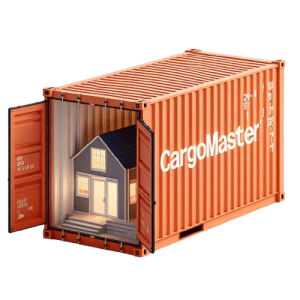 For Tasmanians moving overseas or sending large shipments, CargoMaster’s self-pack container service provides an affordable and flexible solution. This option allows you to pack your own goods in your own time while we take care of transportation and logistics. It’s an increasingly popular choice for families relocating, students studying abroad, or businesses sending goods internationally.
For Tasmanians moving overseas or sending large shipments, CargoMaster’s self-pack container service provides an affordable and flexible solution. This option allows you to pack your own goods in your own time while we take care of transportation and logistics. It’s an increasingly popular choice for families relocating, students studying abroad, or businesses sending goods internationally.
We deliver an empty shipping container to your home or business anywhere in Tasmania, giving you the freedom to load it as you wish. Once you’re finished, we collect the container and arrange shipment to your chosen destination. This approach offers both cost savings and greater control over your move.
Self-pack containers are available in a range of sizes, including 20ft and 40ft units, making them suitable for everything from furniture and vehicles to commercial equipment. CargoMaster provides guidance on packing, securing, and preparing your goods for international or domestic shipping.
By choosing CargoMaster’s self-pack container service in Tasmania, you’ll benefit from a simple, secure, and budget-friendly way to move goods across Australia or around the world. It’s the perfect balance of independence and professional support.
Break Bulk, Out of Gauge or Large Bulky Shipping
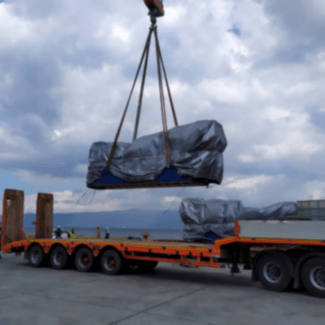 Break bulk shipping remains a vital solution for cargo that cannot fit into standard containers. CargoMaster in Tasmania specialises in handling break bulk and out-of-gauge freight, offering services such as lashing, blocking, and bracing to ensure heavy and oversized goods are safely secured for sea transport. Our team works with marine surveyors to oversee inspections before loading, ensuring compliance with international shipping standards.
Break bulk shipping remains a vital solution for cargo that cannot fit into standard containers. CargoMaster in Tasmania specialises in handling break bulk and out-of-gauge freight, offering services such as lashing, blocking, and bracing to ensure heavy and oversized goods are safely secured for sea transport. Our team works with marine surveyors to oversee inspections before loading, ensuring compliance with international shipping standards.
The term break bulk has its roots in the phrase “breaking bulk,” which referred to the process of unloading a portion of cargo from the hull of a ship. Today, it describes cargo that is loaded individually rather than inside standard shipping containers. Examples include crates, pallets, machinery, steel structures, and industrial equipment. These shipments require specialised handling, making experience and precision essential for success.
Break bulk shipping is one of the oldest methods of transporting goods across oceans, and while containerisation has become the standard for most cargo, break bulk remains indispensable for industries such as mining, construction, and energy. In Tasmania, CargoMaster provides tailored solutions for companies moving everything from industrial machinery to oversized building components, ensuring smooth coordination from pickup to final delivery.
With over 35 years of experience, CargoMaster is among the few Australian specialists equipped to handle complex break bulk cargo movements from Tasmania. Choosing the right freight forwarder for these shipments is critical. Incorrect handling or inexperience can lead to costly delays, damage, or even cargo loss. By relying on CargoMaster, clients gain access to a trusted partner with proven resources, expertise, and industry knowledge.
Why CargoMaster
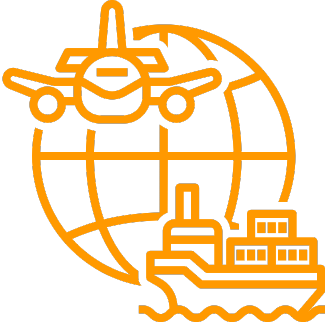 With so many freight options available, why choose CargoMaster for your Tasmanian shipping needs? The answer lies in our experience, reliability, and commitment to customer service. We understand the unique challenges of freight forwarding in Tasmania and design solutions that keep your goods moving efficiently.
With so many freight options available, why choose CargoMaster for your Tasmanian shipping needs? The answer lies in our experience, reliability, and commitment to customer service. We understand the unique challenges of freight forwarding in Tasmania and design solutions that keep your goods moving efficiently.
Our team is made up of logistics experts who manage every step of the process, from planning and paperwork to delivery. Whether it’s air freight, sea freight, self-pack containers, or air charters, CargoMaster provides services that combine competitive pricing with outstanding reliability.
Tasmanian businesses and individuals benefit from our strong global network and industry partnerships, which enable us to deliver consistent and cost-effective solutions. We take pride in offering flexible options that cater to everyone from small businesses to large-scale exporters.
By choosing CargoMaster, you’re choosing a freight forwarder that puts your needs first. With a focus on efficiency, affordability, and trust, we ensure your cargo is delivered safely and on time, every time. For reliable freight forwarding in Tasmania, CargoMaster is the partner you can depend on.
Frequently Asked Questions
What does an international freight forwarder do?
An international freight forwarder manages the movement of goods both within Australia and across the globe. They coordinate transport by sea, air, rail, and road to ensure shipments move quickly, safely, and cost-effectively. For importers and exporters, experienced forwarders like CargoMaster provide expert assistance with logistics, customs documentation, and all compliance requirements.
What’s the best freight forwarder?
CargoMaster is widely recognised as one of Australia’s most trusted freight forwarders. With proven experience in both domestic and international freight, CargoMaster offers tailored solutions to meet your shipping needs.
How much does a freight forwarder cost?
The cost of freight forwarding depends on several factors, including the mode of transport, shipment size and weight, origin and destination, and the type of goods being moved. CargoMaster provides competitive sea freight and air freight quotes to ensure customers receive cost-effective solutions.
How do freight forwarders get paid?
Freight forwarders are usually paid upon presentation of the required international shipping documentation. In cases where services are prepaid, an invoice is issued once the booking is confirmed. This process ensures transparency for both parties.
How are freight charges calculated?
Freight charges are based on key elements such as the mode of transport, shipment dimensions, weight, origin and destination, and any special handling requirements. CargoMaster works closely with clients to provide accurate and transparent cost estimates.
What is the role of a freight forwarder?
A freight forwarder’s role goes beyond simply transporting cargo. They manage logistics, customs clearance, packaging, labelling, insurance, warehousing, and all necessary documentation. This makes them an essential partner for businesses and individuals moving goods internationally.
New Zealand West Africa Croatia USA United Kingdom
Addition Information
(Click the +/- plus/minus symbols to expand/collapse)
SHIPPING CONTAINER DIMENSIONS
20 ft Standard Dry (8'6" x 8' x 20')
Weight: 4500lbs
Max Gross Weight: 66,139lbs
Interior Dimensions:
Length: 19′ 5″
Width: 7′ 8-⅛”
Height: 7′ 9-⅝”
Door Opening:
Width: 7’ 8-½”, Height: 7’ 5-¾”
40 ft Standard Dry (8'6" x 8' x 40')
Weight: 8500lbs
Max Gross Weight: 66,139lbs
Interior Dimensions:
Length: 39′ ⅜”
Width: 7′ 8-⅛”
Height: 7′ 9-⅝”
Door Opening:
Width: 7’ 8-½”, Height: 7’ 5-¾”
40 ft High Cube (9'6" x 8' x 40')
Weight: 8750 lbs
Max Gross Weight: 68,008lb
Interior Dimensions:
Length: 39′ 4”
Width: 7′ 7”
Height: 8′ 9″
Door Opening: Width:
7’ 8″‘, Height: 8’ 5”
 Dimensions of 20ft Flat Rack Container
Dimensions of 20ft Flat Rack Container
Internal length 5.94 m / 19.5 ft
Internal width 2.35 m / 7.7 ft
Internal height 2.35 m / 7.7 ft
Tare weight 2,360 kg / 5,203.8 lbs
Payload capacity: 30,140 kg / 66,458.7 lbs
Cubic capacity 32.7 m³ / 1,154.3 cu ft
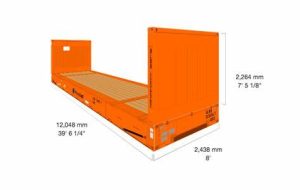 Dimensions of 40ft Flat Rack Container
Dimensions of 40ft Flat Rack Container
Internal length 12.13 m / 39.8 ft
Internal width 2.40 m / 7.9 ft
Internal height 2.14 m / 7 ft
Tare weight 5,000 kg / 11,025 lbs
Payload capacity: 40,000 kg / 88,200 lbs
Cubic capacity 62.2 m³ / 2,195.7 cu ft
INTERNATIONAL AIRPORTS
|
|
HIDDEN DANGEROUS AIR CARGO
Please Note: The below list does not describe all types of hazardous air cargo (it is not exhaustive and all encompassing). General items listed below may be found in baggage and possibly have hazards that are not immediately apparent. There are strict laws in relation to lodging of hazardous air cargo and compliance with hazardous air cargo regulations.
Typical examples of hazardous air cargo
Engines (contain fuel and that are not cleaned, purged and sealed)
Mining equipment
Magnets
Pressurised containers
Passenger baggage (containing flammable gas or liquid lighter refuel. camping stove cylinders
Photographic Supplies
Expeditionary equipment
Vaccines
Solvents, adhesives
Pesticides
Dental apparatus
Machinery parts
Frozen foods (packed in solid dry ice)
Dry Ice
Tool Boxes (compressed gases, aerosols)
Electrical equipment
Diving equipment
Pharmaceuticals
Switches in electrical equipment
Toys (made of cellulose)
Refrigerators (may contain gases or chemicals)
Swimming pool chemicals
Pressurised containers
Engines (contain fuel and that are not cleaned, purged and sealed)
Mining equipment
Diagnostic specimens
Thermometers (containing mercury)
Frozen Embryos
Ammunition
Swimming pool chemicals
Aerosols
Compressed non-flammable gas
Batteries
Breathing Apparatus
Frozen foods (packed in solid dry ice)
Motor Vehicle parts
Chemicals
HAZARD LABELS DANGEROUS GOODS (DG)
Hazard Labels for
Dangerous Goods (DG)
The international community has established a classification system for easy identification of dangerous goods. These goods fall into nine primary classes, and some classes are further divided to address specific risks. Each class/division has a corresponding label that accurately represents the nature of the hazard. These labels must be attached to the package during transport and remain intact throughout the journey. Take a look at the illustrated examples below to understand how these labels effectively communicate the potential dangers.
Under regulations, labels must be clearly visible on the outside of the package and must stay on the package while in transit.
You can often find labels printed on most inner packages such as:
- aerosol cans
- bottles of bleach
- containers of thinners
- tins of paint
- many other products which are available at supermarkets and hardware stores.
Below are the 9 hazard labels for the 9 classes of dangerous goods.
Class 1 Explosives

This includes items such as:
- explosive substances
- pyrotechnic devices
- ammunition
- fireworks
- detonators.
Class 2 Gases

These can be transported as:
- compressed
- liquefied
- refrigerated liquefied
- gas in solution.
This includes aerosols. Class 2 has 3 divisions:
- Division 2.1 - flammable gases such as:
- butane
- propane
- Division 2.2 - non-flammable, non-toxic gases such as:
- oxygen
- liquid nitrogen
- compressed air
- Division 2.3 - toxic gases such as:
- chlorine
- hydrogen sulphide.
Class 3 Flammable liquids

This includes liquids with a boiling point of 35⁰ C or less, or a flash point of 60⁰ C or less such as:
- petrol
- alcohol
- perfumes
- essential oils
- hand sanitiser
- paints.
Class 4 Flammable solids

These are substances that can spontaneously combust and substances, that when they come into contact with water or emit flammable gases. Class 4 has 3 divisions:
- Division 4.1 - flammable solids such as:
- hexamine solid fuel tablets for camping stoves
- self-reactive substances
- desensitised explosives
- Division 4.2 - substances that can spontaneously combust under normal air transport conditions include:
- camphor
- sulphur
- matches
- Division 4.3 - substances that emit flammable gases when they come into contact with water include:
- sodium
- zinc particles
- activated carbon.
Class 5 Oxidising substances and organic peroxides

These substances are not necessarily combustible on their own but can react dangerously with other substances. Class 5 has 2 divisions:
- Division 5.1 - oxidising substances that may not be necessarily combustible, but they may readily yield oxygen and cause other materials to combust, such as:
- hydrogen peroxide
- ammonium nitrate
- potassium chlorate
- sodium nitrate
- Division 5.2 - organic peroxides are thermally unstable and can emit heat and give off harmful or flammable vapours. They can also be liable to explosive decomposition and react dangerously with other substances. Examples are:
- acetyl acetone peroxide
- benzoyl peroxide
- peracetic acid.
Class 6 Toxic and infectious substances

These substances can cause sickness, injury or death if consumed. Class 6 has 2 divisions:
- Division 6.1 - toxic substances that can cause death, injury or to harm human health if swallowed, inhaled or by skin contact, such as:
- chloroform
- arsenics
- cyanides
- cytotoxic waste
- barium compounds
- pesticides
- Division 6.2 - infectious substances that contain or are expected to contain pathogens that can cause disease in humans or animals, including:
- medical or clinical waste
- patient specimens
- genetically modified organisms
- infectious substances
- infected animals.
Class 7 Radioactive materials

These are substances that emit invisible ionising radiation that can be harmful to humans and animals. It can cause objects such as aircraft and equipment to become contaminated if not packaged and handled correctly, such as:
- uranium
- radioactive ores
- isotypes
- radium
- cesium
- x-ray equipment
- medical equipment or parts.
Class 8 Corrosives

These substances can cause irreversible damage if they come into contact with skin and could destroy other freight, or materially damage containers or aircraft. This includes:
- acids
- corrosive cleaners
- battery fluid
- formaldehyde
- hydrofluoric acid.
Class 9 Miscellaneous

These are substances and articles which, during air transport, present a danger not covered by other classes. There are 2 types of handling labels – 1 for lithium battery shipments, and another for all other miscellaneous dangerous goods. This class includes:
- lithium batteries
- battery powered vehicles
- battery powered equipment
- first aid kids
- environmentally hazardous substances
- dry ice
- magnetised materials
- asbestos.
Handling labels
In addition to hazard labels, trained staff must attach handling labels where needed. Staff must use these 4 handling labels with the appropriate hazard labels:
Cargo aircraft only

This label is used to show that the load cannot be carried on a passenger aircraft.
Cyrogenics

This label is used on liquefied gases, such as the ones in Class 2.
This way up

This label ensures a load is placed the correct way up and can be used for non-dangerous goods.
Magnetised material

This label ensures that the load is kept away from the aircraft compass detector unit while being loaded and unloaded.
IATA CODES FOR MAJOR AUSTRALIAN AIRPORTS
| Airport | IATA code | ICAO code |
| Adelaide | ADL | YPAD |
| Alice Springs | ASP | YBAS |
| Brisbane | BNE | YBBN |
| Cairns | CNS | YBCS |
| Canberra | CBR | YSCB |
| Darwin | DRW | YPDN |
| Gold Coast | OOL | YBCG |
| Hobart | HBA | YMHB |
| Launceston | LST | YMLT |
| Melbourne (Avalon) | AVV | YMAV |
| Melbourne (Tullamarine) | MEL | YMML |
| Perth | PER | YPPH |
| Sunshine Coast | MCY | YBSU |
| Sydney | SYD | YSSY |
| Townsville | TSV | YBTL |
INTERNATIONAL FREIGHT FORWARDERS
Asociacion Argentina De Agentes De Carga Internacional -Aaaci -
Association Of Armenian Freight Forwarders
Customs Brokers And Forwarders Council Of Australia Inc
Zentralverband Spedition & Logistik -Zv-
Bangladesh Freight Forwarders Association -Baffa-
Belarussian Association Of International Forwarders -Baif-
Confederation Des Expediteurs De Belgique -Ceb-
Foreign Trade Chamber Of Bosnia And Herzegovina International Freight Forwarders Association
Brunei Freight Forwarders Association -Brufa-
The Bulgarian Association For Freight Forwarding, Transport And Logistics -Nsbs-
Cambodian Freight Forwarders Association -Camffa-
Syndicat National Des Auxiliaires De Transports Et De Transit - Synautratra
Canadian International Freight Forwarders Association Inc
Asociacion Logistica De Chile A.G. - Alog Chile
China International Freight Forwarders Association -Cifa-
International Ocean Freight Forwarders & Logistics Association, Taiwan -Iofflat-
Federacion Colombiana De Agentes Logisticos En Comercio Internacional -Fitac-
Asociacion Costarricense De Agencias De Carga Y Logistica Internacional -Acacia-
Croatian Chamber Of Economy International Freight Forwarders Association Of Croatia
Cyprus Clearing And Forwarding Agents Association -Ccfaa-
Association Of Forwarding And Logistics Of The Czech Republic -Ssl
The Danish Freight Forwarders Association -Dsf-
Asociacion Dominicana De Agentes De Carga Aerea Y Maritima - Adacam -
Asociacion Ecuatoriana De Agencias De Carga Y Logistica Internacional -Aseaci-
Egyptian International Freight Forwarding Association -Eiffa-
Asociacion Salvadorena De Agencias De Carga Y Servicios Conexos De Exportacion
Estonian Logistics & Freight Forwarding Association - Elfa
Ethiopian Freight Forwarders And Shipping Agents Association - Effsaa -
Finnish Freight Forwarding And Logistics Association
Union Des Entreprises De Transport Et Logistique De France -Tlf-
National Association Of Freight Forwarders Of Georgia -Afg-
Deutscher Speditions- Und Logistikverband E.V. -Dslv-
Ghana Institute Of Freight Forwarders -Giff-
Association Of International Freight Forwarders & Logistics Enterprises Of Greece -Iffag&L-
Asociacion Hondurena De Agencias De Carga Y Logistica Internacional - Ahaci
Hongkong Association Of Freight Forwarding And Logistics Ltd. -Haffa-
Magyar Szallitmanyozok Szovetsege - Association Of Hungarian Forwarders
Federation Of Freight Forwarders' Associations In India - Fffai
International Transport Companies Association Of Iran -Itca-
Irish International Freight Association -Iifa-
The Israeli Federation Of Forwarders And Customs Clearing Agents -Iffcca-
Federazione Nazionale Delle Imprese Di Spedizioni Internazionali - Fedespedi -
Jordanian Logistics Association - Jla
Association Of National Freight Forwarders Of The Rep. Of Kazakhstan -Kffa-
Korea International Freight Forwarders Association -Kiffa-
Latvian National Association Of Freight Forwarders And Logistics -Laff-
Lfs - Lebanese Forwarders Syndicate
Lithuanian National Association Of Forwarders And Logistics - Lineka
Mifa - Macedonian International Freight Forwarding And Logistics Operators Association
Federation Of Malaysian Freight Forwarders -Fmff-
The Malta Chamber Of Commerce, Enterprise And Industry
Association Professionnelle Des Transitaires Et Assimiles -Apt-
Asociacion Mexicana De Agentes De Carga, A.C. -Amacarga-
Federation Of Mongolian Freight Forwarders - Fmff -
Fenex - Netherlands Association For Forwarding And Logistics
Customs Brokers & Freight Forwarders Fed. Of New Zealand Inc. -Cbaff-
Asociacion Nicaraguense De Agencias De Carga, (Anac)
The Council For The Regulation Of Freight Forwarding In Nigeria
Norwegian Logistics And Freight Association
Pakistan International Freight Forwarders Association -Piffa-
Asociacion Panamena De Agencias De Carga - Apac -
Asociacion De Transitarios Del Paraguay Y Operadores Logisticos -Atolpar-
Federation Of Forwarders Associations In The Philippines (Inc.) -Fedfap-
Polish International Freight Forwarders Association - Piffa -
Associacao Dos Transitarios De Portugal - Apat -
L'union De Societes D'expeditions De La Roumanie -User-
Freight Forwarders Association Of Russian Federation -Far-
Chamber Of Commerce And Industry Of Serbia (Ccis) - Association For Transport And Telecommunications
Singapore Logistics Association -Sla-
Association Of Logistics And Freight Forwarding Of The Slovak Republic -Zlz Sr-
The South African Association Of Freight Forwarders -Saaff-
Federacion Espanola De Transitarios, Expedidores Internacionales Y Asimilados -Feteia-
Sri Lanka Logistics & Freight Forwarders Association - Slffa -
Swedish International Freight Association -Sifa-
Spedlogswiss Verband Schweizerischer Speditions- Und Logistikunternehmen
Syrian International Freight Forwarding Association - Siffa
Thai International Freight Forwarders Association -Tiffa-
International Transporters Association -U.N.D.-
Uganda Freight Forwarders' Association -Uffa-
Ukrzovnishtrans - Association Of Transport Forwarding And Logistics Organizations Of Ukraine
National Association Of Freight And Logistics -Nafl-
British International Freight Association -Bifa-
Transportation Intermediaries Association -Tia-
Audaca - Asociacion Uruguaya De Agentes De Carga
Uzbek International Forwarders Association -Uifa-
Vietnam Logistics Business Association - Vla -
The Shipping And Forwarding Agents Association Of Zimbabwe -Sfaaz-
AIR FREIGHT FREIGHTER SPECIFICATIONS
| Make/Model | Max Payload Tonnes | Max Loadable Volume CBM3 | Cargo Hold Dims LxWxH cm | Cargo Door Size WxH cm |
| Cessna 406 Titan | 1.2 | 6.5 | 320 x 120 x 117 | 124 x 116 |
| Fairchild Metroliner II | 1.4 | 12 | 835 x 115 x 120 | 130 x 115 |
| Fairchild Metroliner III | 2.1 | 12 | 775 x 158 x 145 | 130 x 115 |
| Fairchild Metroliner 23 | 2.3 | 18 | 775 x 158 x 145 | 127 x 115 |
| Falcon 20 / 200 | 2.5 | 11 | 704 x 156 x 142 | 190 x 140 |
| Shorts 360 | 3.5 | 40 | 815 x 190 x 190 | 142 x 168 |
| Saab 340 | 3.8 | 40 | 1300 x 170 x 170 | 135 x 130 |
| Aerospatiale ATR42 | 4.6 | 40 | 1080 x 225 x 143 | 125 x 153 |
| Fokker 27 | 6.3 | 58 | 1336 x 210 x 190 | 228 x 175 |
| Antonov AN-26 | 6.5 | 45 | 1110 x 220 x 160 | 230 x 171 |
| Antonov AN-74 | 6.5 | 45 | 1000 x 215 x 220 | 226 x 220 |
| British Aerospace ATP | 8.2 | 78 | 1500 x 195 x 180 | 250 x 169 |
| Lockheed L-188 Electra | 15 | 135 | 2000 x 280 x 220 | 355 x 203 |
| Boeing 737-300F | 16 | 115 | 2100 x 310 x 220 | 340 x 215 |
| Antonov AN-12 | 18 | 95 | 1380 x 300 x 250 | 300 x 250 |
| Lockheed L-100 Hercules | 21 | 140 | 1707 x 302 x 274 | 302 x 274 |
| Boeing 727-200F | 23.5 | 144 | 2712 x 351 x 218 | 340 x 218 |
| Boeing 757F | 39 | 187 | 3327 x 353 x 218 | 340 x 218 |
| Airbus A300 B4F | 40 | 280 | 3900 x 477 x 223 | 358 x 256 |
| Douglas DC8-62 | 40 | 200 | 3400 x 317 x 203 | 355 x 215 |
| Douglas DC8-54/55 | 41 | 180 | 3100 x 317 x 203 | 355 x 215 |
| Ilyushin IL-76 | 45 | 180 | 1850 x 345 x 325 | 344 x 340 |
| Antonov AN-22 | 50 | 650 | 2640 x 430 x 430 | 430 x 430 |
| Lockheed L10-11 Tristar | 55 | 420 | 3300 x 360 x 274 | 431 x 284 |
| Boeing 767-300F | 55 | 400 | 3000 x 400 x 250 | 340 x 254 |
| Douglas DC10-30 | 65 | 400 | 3725 x 448 x 245 | 350 x 245 |
| McDonnell Douglas MD11 | 85 | 500 | 4800 x 350 x 245 | 355 x 245 |
| Boeing 747-100F | 90 | 675 | 4800 x 488 x 300 | 340 x 300 |
| Boeing 747-200F | 100 | 675 | 4900 x 488 x 300 | 340 x 300 |
| Boeing 777F | 100 | 625 | 4400 x 488 x 300 | 372 x 305 |
| Boeing 747-300/400F | 110 | 675 | 5000 x 488 x 300 | 340 x 300 |
| Antonov AN-124 | 120 | 800 | 3650 x 640 x 440 | 640 x 440 |
| Antonov AN-225 | 250 | 1100 | 4300 x 640 x 440 | 640 x 440 |
UNIT LOAD DEVICES (ULD)
ULDs are considered an aircraft part and are the only aircraft parts that can be removed from the aircraft and be returned after being handled by unregulated operators, ULD's are considered to directly contribute to flight safety.
Types of Unit Load Devices Used in Australia
AKE Container
- Type: AKE CONTAINERATA Code: LD3
- Internal Volume: 152 cu. ft. 4.3 mc
- Weight Limit: 1,588 kg
- Loadable Aircraft Type: 747, 747F, 777, Airbus
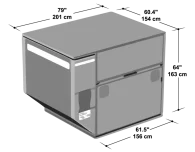 AAU Container
AAU Container
- Type: AAU CONTAINER
- ATA Code: LD29
- Internal Volume: 505 cu. ft. 14.3 mc
- Weight Limit: 4,626 kg
- Loadable Aircraft Type: 747, 747F
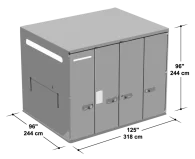 ALF Container
ALF Container
- Type: ALF CONTAINER
- ATA Code: LD6
- Internal Volume: 310 cu. ft. 8.78 mc
- Weight Limit: 3,175 kg
- Loadable Aircraft Type: 747, 747F,777, Airbus
 AMA Container
AMA Container
- Type: AMA CONTAINER
- ATA Code: M1
- Internal Volume: 621 cu. ft. 17.58 mc
- Weight Limit: 6,804 kg
- Loadable Aircraft Type: 747F
 AMF Container
AMF Container
- Type: AMF CONTAINER
- Internal Volume: 516 cu. ft. 14.6 mc
- Weight Limit: 5,035 kg
- Loadable Aircraft Type: 747,747F, 777, Airbus
P1P_PAG Pallet
- Type: P1P, PAG PALLET
- Size:
- Base: 88″x 125″
- Height: 64″, x 96″,118″
- Weight Limit: 4,626kg
(LD),6,033kg (MD) - Loadable Aircraft Type: 747,747F, 777, Airbus
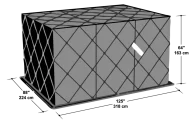 PEB Container
PEB Container
- Type: PEB CONTAINER
- Size:
- Base: 53″ x 88″
- Height: 84″
- Weight Limit: 1,800kg
(B-HIH -1,300 KG) - Loadable Aircraft Type: 747F
 PLA Pallet
PLA Pallet
- Type: PLA PALLET
- Size:
- Base: 60.4″x 125″
- Height: 64″
- Weight Limit: 3,175kg
Loadable Aircraft Type: 747, 747F, 777, Airbus
 PMC_PQP_P6P Pallet
PMC_PQP_P6P Pallet
- Type: PMC, PQP, P6P PALLET
- Size: Base: 96″ x 125″
- Weight Limit: 5,035 kg (LD), 6,804 kg (MD)
- Loadable Aircraft Type: 747, 747F, 777, Airbus
 RKN Container
RKN Container
- Type: RKN CONTAINER
- ATA Code: LD3
- Internal Volume: 125.41 cu. ft. 3.55 mc
- Weight Limit: Weight: 1,588 kg
- Loadable Aircraft Type: 747, 747F, 777, Airbus
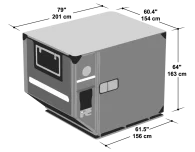 VZA_VRA
VZA_VRA
- Size: Fitted on PGA 20 ft. Pallet
- Max Width for Lower Car: 81″/ 205 cm
- Max Centre Height for Lower Car: 59″/ 150 cm
- Max Wheel Base: 312 cm
- Weight Limit: 2,500 kg(Upper Car)
9,300 kg c(Max Gross Weight of Pallet) - Loadable Aircraft Type: 747F Upper Deck
INTERNATIONAL CONTAINER SHIPPING PORTS
| Rank | Port | Website | ||||
| 1 | Shanghai, China | www.portshanghai.com.cn | ||||
| 2 | SIngapore | www.singaporepsa.com | ||||
| 3 | Shenzhen, China | www.szport.net | ||||
| 4 | Hong Kong, S.A.R., China | www.mardep.gov.hk | ||||
| 5 | Ningbo-Zhoushan, China | www.zhoushan.cn/english | ||||
| 6 | Busan, South Korea | www.busanpa.com | ||||
| 7 | Qingdao, China | www.qdport.com | ||||
| 8 | Guangzhou Harbor, China | www.gzport.com | ||||
| 9 | Jebel Ali, Dubai, United Arab Emirates | www.dpworld.ae | ||||
| 10 | Tianjin, China | www.ptacn.com | ||||
| 11 | Rotterdam, Netherlands | www.portofrotterdam.com | ||||
| 12 | Port Klang, Malaysia | www.pka.gov.my | ||||
| 13 | Kaohsiung, Taiwan, China | www.khb.gov.tw | ||||
| 14 | Dalian, China | www.dlport.cn | ||||
| 15 | Hamburg, Germany | www.hafen-hamburg.de | ||||
| 16 | Antwerp, Belguim | www.portofantwerp.com | ||||
| 17 | Xiamen, China | www.portxiamen.gov.cn | ||||
| 18 | Tanjung Pelepas, Malaysia | www.ptp.com.my | ||||
| 19 | Los Angeles, U.S.A. | www.portoflosangeles.org | ||||
| 20* | Keihin Ports, Japan | www.city.yokohama.lg.jp/en | ||||
| 21 | Long Beach, U.S.A. | www.polb.com | ||||
| 22 | Laem Chabang, Thailand | www.laemchabangport.com | ||||
| 23 | Tanjung Priok, Jakarta, Indonesia | www.priokport.co.id | ||||
| 24 | Ho Chi Minh, Vietnam | www.vpa.org.vn | ||||
| 25 | Bremen/Bremerhaven, Germany | www.bremen-ports.de | ||||
| 26 | New York-New Jersey, U.S.A. | www.panynj.gov | ||||
| 27 | Yingkou, China | www.ykport.com.cn | ||||
| 28** | Hanshin Ports, Japan | www.hanshinport.co.jp/en | ||||
| 29 | Lianyungun, China | www.lyg.gov.cn | ||||
| 30 | Columbo, Sri Lanka | www.slpa.lk | ||||
| 31 | Algerciras Bay, Spain | www.apba.es | ||||
| 32 | Jawaharlal Nehru, | www.jnport.gov.in | ||||
| 33 | Suzhou, China | suzhou.jiangsu.net/transportation/waterway/port | ||||
| 34 | Valencia, Spain | www.valenciaport.com | ||||
| 35 | Jeddah, Suadi Arabia | www.ports.gov.sa | ||||
| 36 | Sharjah, United Arab Emirates | www.sharjahports.ae | ||||
| 37 | Felixstowe, U.K. | www.portoffelixstowe.co.uk/ | ||||
| 38 | Santos, Brazil | www.portodesantos.com | ||||
| 39 | Manila, Philippines | www.ppa.com.ph | ||||
| 40 | Piraeus, Greece | www.pct.com.gr www.olp.gr/en | ||||
| 41 | Port Said East, Egypt | www.scctportsaid.com | ||||
| 42 | Balboa, Panama | www.ppc.com.pa/balboa.php | ||||
| 43 | Haiphong, Vietnam | www.vpa.org.vn | ||||
| 44*** | Seattle-Tacoma NW Seaport Alliance, U.S.A. | www.portseattle.org www.porttacoma.org | ||||
| 45 | Ambarli, Turkey | www.atlasliman.com | ||||
| 46 | Georgia Ports, U.S.A. | www.gaports.com | ||||
| 47 | Colon, Panama | www.amp.gob.pa | ||||
| 48 | Tanjung Perak, Surabaya, Indonesia | www.perakport.co.id | ||||
| 49 | Tanger Med, Morocco | www.tmpa.ima | ||||
| 50 | Salalah, Oman | www.salalah.com |
INCOTERMS
INCOTERMS are standard trade terms most commonly used in international freight contracts for sale of goods. It is essential that you are aware of your terms of trade prior to shipment.
EXW – EX WORKS (… named place of delivery)
The Seller’s only responsibility is to make the goods available at the Seller’s premises. The Buyer bears full costs and risks of moving the goods from there to destination.
FCA – FREE CARRIER (… named place of delivery)
The Seller delivers the goods, cleared for export, to the carrier selected by the Buyer. The Seller loads the goods if the carrier pickup is at the Seller’s premises. From that point, the Buyer bears the costs and risks of moving the goods to destination.
CPT – CARRIAGE PAID TO (… named place of destination)
The Seller pays for moving the goods to destination. From the time the goods are transferred to the first carrier, the Buyer bears the risks of loss or damage.
CIP– CARRIAGE AND INSURANCE PAID TO (… named place of destination)
The Seller pays for moving the goods to destination. From the time the goods are transferred to the first carrier, the Buyer bears the risks of loss or damage. The Seller, however, purchases the cargo insurance.
DAT – DELIVERED AT TERMINAL (… named terminal at port or place of destination)
The Seller delivers when the goods, once unloaded from the arriving means of transport, are placed at the Buyer’s disposal at a named terminal at the named port or place of destination. “Terminal” includes any place, whether covered or not, such as a quay, warehouse, container yard or road, rail or air cargo terminal. The Seller bears all risks involved in bringing the goods to and unloading them at the terminal at the named port or place of destination.
DAP – DELIVERED AT PLACE (… named place of destination)
The Seller delivers when the goods are placed at the Buyer’s disposal on the arriving means of transport ready for unloading at the names place of destination. The Seller bears all risks involved in bringing the goods to the named place.
DDP – DELIVERED DUTY PAID (… named place)
The Seller delivers the goods -cleared for import – to the Buyer at destination. The Seller bears all costs and risks of moving the goods to destination, including the payment of Customs duties and taxes.
MARITIME TERMS
FAS – FREE ALONGSIDE SHIP (… named port of shipment)
The Seller delivers the goods to the origin port. From that point, the Buyer bears all costs and risks of loss or damage.
FOB– FREE ON BOARD (… named port of shipment)
The Seller delivers the goods on board the ship and clears the goods for export. From that point, the Buyer bears all costs and risks of loss or damage.
CFR– COST AND FREIGHT (… named port of destination)
The Seller clears the goods for export and pays the costs of moving the goods to destination. The Buyer bears all risks of loss or damage.
CIF – COST INSURANCE AND FREIGHT (… named port of destination)
The Seller clears the goods for export and pays the costs of moving the goods to the port of destination. The Buyer bears all risks of loss or damage. The Seller, however, purchases the cargo insurance.
FREIGHT TERMS AND ABBREVIATIONS
| A2A | Airport-to-airport |
| A2D | Airport-to-door |
| ADV | Advise, Advised, Advising |
AEA | Association of European Airlines (see the page “Interest Organisations” of this website also) |
Airline | Company operating aircraft between steady origin and destination airports |
| Airmail | Mail travelling by air |
| Air Operator | Company operating aircraft |
Airport-to-airport | Transport from an airport of origin to an airport of destination |
Allotment | Assigned volume on board of a flight / day |
AOG | Aircraft On Ground; materials expedited for repair of a grounded aircraft |
| AP | Airport |
| ARR | Arrive, Arrived, Arrival |
| ARR | Also, a C2K milestone: ARR = cargo and documents arrived at airport of destination |
| ATA | Air Transport Association (see the page “Interest Organisations” of this website also) |
| ATA | Actual Time of Arrival |
| ATD | Actual Time of Departure |
| Authorisation | The commission to a certain person or body to act on behalf of another person or body; the person or body can be authorised e.g., to issue air waybills or to collect freight |
| AVI | Live Animal(s) |
| AWB | Air Waybill |
| Backlog | Amount of goods still to be delivered or received and for which the planned or agreed date has expired |
| BAG | Baggage |
| Belly | Lower-deck cargo hold of an aircraft |
| BIG | Outsized cargo |
| Blocked-space agreement | A continuous reservation (allotment) for space at one or more flight / date combinations with an airline |
| Bonded Goods | Goods on which the customs duty has not yet been paid, and which therefore, are under the control of customs; usually in a Bonded warehouse. |
| Bonded warehouse | A depository for goods on which the customs duty has not been paid; the warehouse proprietor must provide a bond (often in the form of a bank warranty or a mortgage) to the customs authorities as a security for any duties which may not be paid by the customer |
| Booking | Request for reservation of space on a flight/day, (to be) confirmed by the airline |
| Break Bulk Agent | A forwarder breaking the bulk: taking care of the unpacking and sorting of goods after the flight |
| Breakdown List | List of shipments carried in one consolidation (see also: Consolidation Manifest) |
| Broker | Person who acts as an agent or intermediary in negotiating contracts; sometimes refers to a forwarder role |
| Bulk Cargo | Loose cargo not loaded on an ULD |
| C2K | Cargo 2000 (see the “Cargo 2000” page of this website) |
| Cargo Aircraft | Aircraft built with the purpose of carrying nothing else than cargo |
| Cargo assembly | The separate reception of parcels or packages and the holding of them for later dispatch as one consignment; consolidator role |
| Cargo Disassembly | The separation of one or more of the parcels or packages that are part of a consignment for further distribution; break bulk role |
| Carriage | Transport; the process of conveying cargo from one point to another |
| Carrier | The party responsible for transport of goods from one point to another, this can be for example an airline or a forwarder (as a NVOCC) |
| CASS | Cargo Accounts Settlement System |
| CAO | Cargo Aircraft Only |
| CC | Charges Collect; pay at moment of collection of the goods |
| CCS | Cargo Community System; information system integrating the communication between air cargo parties at an airport |
| Certificate of Origin | A certificate proving the country of original production of goods; used for customs declaration purposes |
| Charges collect | Charges as stated on the air waybill to be collected from the consignee |
| Charges prepaid | Charges as stated on the air waybill to be collected from the shipper |
| Claim | A written complaint about the execution of a contract of transportation by a carrier, combined with a demand for financial compensation |
| Classifying | Assigning the right import classification number to goods as part of the customs declaration process |
| CLR | Clear |
| CNEE | Consignee |
| COLL | Collect, Collected, Collecting |
| COMAT | Company Material (non-revenue cargo) |
| Combi | Combi Aircraft, combining transport of passengers and cargo on the main-deck |
| Commodity | Indication of the type of goods; commodities are coded according to the harmonised system. |
| Commodity code | Code used in the Harmonised System for the classification of goods, which are most commonly produced and traded |
| Complaint | An official statement from a customer to a carrier about his unhappiness with the service or operation of the service provider |
| Consignee | The person or company that is physically and administratively responsible for accepting the goods at final delivery |
| Consolidation | A collection of shipments belonging to different shippers travelling to one destination or area to be distributed to several consignees |
| Consolidation Manifest | List of shipments carried in one consolidation |
| Consolidation Rates | Rates as given by a consolidator / forwarder |
| Consolidator | A forwarder consolidating shipments before a flight; these shipments belonging to different shippers and travelling to one destination or area in order to be distributed to several consignees after the flight |
| Courier | Company that carries envelopes and parcels up to 75 kg from door to door; air transport is generally outsourced to airlines |
| Courier Rates | Rates as given by a courier |
| CPTY | Capacity |
| CRN | Customs Release Note |
| Customs Agent/Broker (Certified) | Party certified to handle the customs clearance on account of importers / exporters |
| Customs invoice | (Pro forma) Invoice for import declaration (customs and statistics) purposes, stating the commercial price, added with the costs for freight, insurance and packing etc., terms of delivery and payment |
| Customs value | Value of goods to be imported for import declaration (customs and statistics) purposes |
| D2A | Door-to-airport |
| D2D | Door-to-door |
| Dangerous Goods | Goods that can be hazardous for health, flight-safety or materials |
| DAP | A C2K key performance indicator: DAP = Delivered as Promised (NFD in full- and on-time statuses are achieved) |
| DEP | A C2K milestone: DEP = cargo and documents departed at airport of origin |
| DEPT | Department |
| DG | Dangerous Goods |
| DGR | Dangerous Goods Regulations (IATA) |
| Dimensional Weight (Conversion) | Concept adopted by the transportation industry worldwide as a uniform means of establishing a minimum charge for the cubic space a package occupies; the volume is converted into a (higher) weight / price class |
| DIMS | Dimensions |
| DIP | Diplomatic mail |
| DLV | Deliver, Delivered, Delivering |
| DLV | Also, a C2K milestone: DLV = cargo and documents delivered to customer (forwarder) |
| DOCS | Document(s), Documentation |
| Domestic transport | Transport within a country |
| Door-to-door | Transport from an initial shipper’s house address to a final consignee’s house address |
| Duty | Tax imposed on goods imported from another country |
| EDI | Electronic Data Interchange |
| EDIFACT | Electronic Data Interchange for Administration, Commerce and Transport; a specific EDI protocol |
| e-Freight | Electronic freight documents project from IATA; e-Freight aims to take the paper out of the air cargo supply chain and -processes and replace it with cheaper, more accurate and more reliable electronic messaging; facilitated by IATA, the project is an industry-wide initiative involving carriers, freight forwarders, ground handlers, shippers and customs authorities |
| Electronic Data Interchange | The interchange of electronic data, structured following an agreed protocol, between the automated information system of different parties |
| Embargo | An embargo on a certain kind of goods means these goods will not be transported by the airline, often for flight-safety reasons |
| Equipment | Materials needed to handle or transport goods |
| ESC | European Shippers’ Council (see the page “Interest Organisations” of this website also) |
| ETA | Estimated Time of Arrival |
| ETD | Estimated Time of Departure |
| Expediting | Forwarding goods (in less than the normal lead time) |
| Expeditor | Forwarder |
| FAK | Freight All Kinds |
| FAK-Rates | Rates for Freight All Kinds |
| FAP | A C2K key performance indicator: FAP = Flown as Planned (the complete shipment has flown at or before the last planned flight with a maximum 12-hour delay) |
| FCL | Full Container Load |
| FDCA | Found Cargo |
| FFM | Freight Forwarding Message (electronic) |
| FIATA | International Federation of Freight Forwarders Associations (see the page “Interest Organisations” of this website also) |
FLT | Flight |
| Forwarder | Company specialized in providing door-to-airport transport, arranging connecting air transport and/or airport-to-door transport for parcels and consolidations > 75 kg or up to anything that fits in an aircraft; the air transport is generally outsourced to airlines and sometimes aircraft operators or air charter companies |
| Forwarder network | A network existing of different smaller to medium sized forwarding companies all over the world working together |
| Freighter | Aircraft built with the purpose of carrying nothing else than cargo |
FSU | Freight Status Update |
| Fuel Surcharge | Surcharge added to the cargo rate to cover the additional costs of increasing fuel-prices; these will generally follow a certain index |
| Full charter | Chartering the full available volume of an aircraft or flight/day |
| Full Container Load | Container fully loaded, generally with goods belonging to one party |
| Full freighter | Aircraft built with the purpose of carrying nothing else than cargo |
FWB | Electronic air waybill message |
| FWB | Also a C2K milestone: FWB = the shipment is booked at the airline, next an electronic air waybill is generated by agent (forwarder) ; this creates the so-called route map in C2K in which all the steps are followed |
FYI | or Your Information |
| General Cargo Rates | Rates for all different kinds of cargo, not falling into a specific handling and/or rate category |
GSA | General Sales Agent |
| GSF | Global Shippers Forum (see the page “Interest Organisations” of this website also) |
| Handling Agent | Agent handling the ramp and/or warehouse cargo operation for an airline |
| Harmonised System | A numeric multi-purpose system for the classification of goods with its six digits covering about 5000 descriptions of the products or groups of products most commonly produced and traded, designed for customs purposes, but can also be used for statistics, transport purposes, export, import and manufacturing; the international convention on the HS was established under auspices of the World Customs Organisation in 1983 |
Haulage | Inland transport of cargo |
| Haulier | Road carrier |
| HEA | Heavy Cargo |
| HAWB | House Air Waybill |
| House Air Waybill | The shipment contract between the end-customer and the forwarder (see the page “Forwarding Out” of this website for further purposes and explanation) |
| Hub | Central point in a transport system or network |
HUM | Human remains |
| HWB | House Waybill |
| IATA | International Air Transport Association (see the page “Interest Organisations” of this website also) |
IATA-Agent | An IATA certified agent |
| ICAL | Inbound Cargo Action List |
| ICAO | International Civil Aviation Organisation (see the page “Interest Organisations” of this website also) |
| ICE | Dry Ice Shipment |
| IN | Inches |
| Inco terms | Internationally agreed set of standard delivery terms |
| Integrator | Carrier integrating different modes of transport to form a door-to-door transport or supply chain; this term mostly refers to the large international express companies whose core business is to carry envelopes and parcels up to 75 kg, often overnight or even same day |
| Intermodal Transport | The movement of cargo in a supply chain by more than one mode of transport; for example, road/air or sea/air transport |
INV | Invoice |
| ISA | If Space Available |
| KG | Kilos |
| L/C | Letter of Credit |
| LCL | Less than Container Load |
| Less than Container Load | Container partly filled with goods from one party, or an amount of goods that is not sufficient to fill one container and will therefore likely be consolidated |
| LHO | Living Human Organs / Blood |
| License, import/export | Governmental permit to import / export certain goods under certain conditions |
| Line item | Order line, each line on a packing list or invoice to be declared for customs |
| Load factor | The extent to which the aircraft (weight-, volume-, ULD-) capacity is efficiently utilized (to generate profit) |
LOC | Location |
| Loose cargo/shipments | Cargo / shipments not loaded on an ULD |
| Lower Deck | The (cargo) deck below the main deck or upper deck of an aircraft |
| LT | Local Time |
| Main deck | Upper deck; the (cargo) deck above the lower deck of an aircraft |
| Manifest, flight | Document listing the air waybills and a specification of the related goods carried on a flight |
| Master Air Waybill | The shipment contract between the forwarder and the airline (see the page “Forwarding Out” of this website for further purposes and explanation) |
| MAWB | Master Air Waybill |
| MFST | Manifest |
| Minimum Rate | Rate to cover the basic costs of carrying a shipment |
| MSG | Message(s) |
| Network Forwarder | A large forwarding company with worldwide branches |
| NFD | A C2K milestone: NFD = cargo and documents ready for pick-up at airline (handler), the customer (forwarder) is notified |
NND | Notice of Non-Delivery |
| NON-IATA | Airline or agent that is not a member of IATA |
| Nose loading | Loading cargo through the cargo door in the nose of an aircraft |
| Notify address | Address of a party other than the consignee to be notified of arrival of the goods |
| Notify party | Party other than the consignee to be notified of arrival of the goods |
| NOTOC | Notification To Captain; list for the captain of the aircraft with goods carried on board |
| N-Rates | Rates for shipments with weights up to 45 kg |
| NVOCC | Non-Vessel Operating/Owning Cargo Carrier; in case of Air Cargo a Carrier (e.g., a Forwarder or Consolidator) who issues Air Waybills for the carriage of cargo on aircraft which he does not operate or own |
OAG | Official Airlines Guide |
| OB | On Board |
| Oversized Cargo | Cargo that exceeds the dimensions of an ULD |
Package | Packed piece of cargo |
| Packing list | A list for customs declaration and consignment purposes stating number and kinds of packages being shipped, totals of gross, legal, and net weights of the packages, marks and numbers on the packages, contents and part-/serial numbers |
| Pallet | A (standardized) platform on which goods can be stacked for transport or warehouse handling purposes |
| Pallet, aircraft | A (standardized) platform on which goods can be stacked for air transport purposes |
| Pallet net | A net used to secure the cargo on the aircraft pallet |
| Parcel | Package |
| Part charter | Chartering of a part of the available volume on an aircraft or flight/day |
| Part shipment | Part of a shipment that travels on a different flight and/or day than the rest of the shipment due to available capacity with the airline |
PAX | Passenger(s) |
| Payload | The (cargo) load that can be carried by an aircraft (to generate revenue) |
| PC | Piece(s) |
| PER | Perishable Cargo |
| PFI | Pro Forma Invoice |
| POA | Proof Of Acceptance; legal proof a shipment has been accepted by a party |
| POD | Proof Of Delivery; legal proof a shipment has been delivered by a party |
| POD | Place Of Delivery |
| PP | Charges Prepaid |
| PPD | Prepaid |
| Pre-alert | Message stating the current and or expected status of the goods |
| Principal | The customer ordering the transport or related services |
PSH | Part Shipment |
| QNTY | Quantity |
| Q-Rates | Rates with a quantity discount |
| RCF | A C2K milestone: RCF = cargo has arrived in the cargo bay at final destination; cargo and airwaybill are administratively received in the system |
RCPT | Receipt, Reception |
| RCS | A C2K milestone: RCS = cargo and documents are received ‘Ready for Carriage’ and accepted by airline (handler) |
| Ready For Carriage | (By Air) The goods are correctly packed and labelled, and customs cleared, with the right documents attached |
| Ready For Transport | (By Road) The goods are correctly packed and labelled, with the right documents attached |
| RFC | Ready For Carriage |
| RFT | Ready For Transport |
| Routing | The path that is (to be) followed by the goods from shipper to consignee |
RUSHR | Rush Reply |
| SASPO | As Soon As Possible |
| SAWB | Substitute Air Waybill |
| Security Surcharge | Surcharge added to the cargo rate to cover the additional costs of the increasing number of security checks and related administration that are legally required by the authorities |
| Shipper | The person or company that is physically and administratively responsible for shipping the goods; for an airline in most cases a forwarder will be the shipper, for a forwarder the shipper is a third party, for example a trading company, a manufacturer, etc. |
| Shipper’s Letter of Instruction | Document issued by the shipper to instruct and authorize the forwarder to forward and declare goods on his behalf; contains all shipment details needed to facilitate these services |
SHPMNT | Shipment |
| Side loading | Loading cargo through a cargo door in the side of an aircraft |
| Skid | Pallet |
| S/L | Short Loaded |
| SLI | Shipper’s Letter of Instruction |
| SSPD | Short Shipped; stayed behind |
| TACT | The Air Cargo Tariff; publication of official airline tariffs |
| TBA | Time Before Arrival |
| TBD | Time Before Departure |
| TEMP | Temperature |
| TIACA | The International Air Cargo Association (see the page “Interest Organisations” of this website also) |
| TILNA | Tilting Not Allowed |
| TILTA | Tilting Allowed |
| Time Slot | The agreed time to collect or deliver goods |
| Tonne Kilometre | One tonne (1000 kg or 2204.6 lb) metric flown one kilometre; productivity indicator |
| TRA | Transit |
| Tracing | Retrieving (information on) the status of goods and documents |
| Tracking | Regular checking on the status of goods and documents |
| Track & Trace | Automated regular retrieval of (information on) the status of goods and documents and checking these against the agreed norms |
| Transfer cargo | Transfer of cargo from one flight to another |
| Transition / Transit cargo | Transfer of cargo from one flight to another |
| TRM | Transfer Manifest |
| TTL | Total |
| ULD | Unit Load Device |
| ULD, contoured | Unit Load Device shaped to exactly fit in an aircraft |
| UNACC | Unaccompanied |
| Unit Load Device | Standardized air cargo loading equipment (pallet, container) |
| Upper deck | Main deck; the (cargo) deck above the lower deck of an aircraft |
| VAL | Valuable cargo |
| VAT | Value Added Tax |
| VOL | Volume |
| Volume charge | Air transport charge based on the volume of goods instead of the actual weight (see “Dimensional Weight” and “Weight charge” also) |
| VUN | Vulnerable cargo |
| Weight charge | Air transport charge based on the actual weight of the goods (see “Dimensional Weight” and “Volume charge” also) |
| Weight & Balance | Management of the weight and allocation of cargo, passengers and fuel for a flight |
W/H | Warehouse |
| XPS | Priority Small Package |
| XS | In Excess |
| Yield management | The process of maximising the contribution (revenue) of the (transport & handling) network, equipment, infrastructure and resources |
Thank-you for contacting us, it’s great that you have selected our contact us page, we appreciate the opportunity, if your shipment relates to air freight or less than a container load sea freight, please include the weight and dimensions of each piece in your request. We look forward to working with you, please feel free to call at any time.
Call: 1300 767 136

